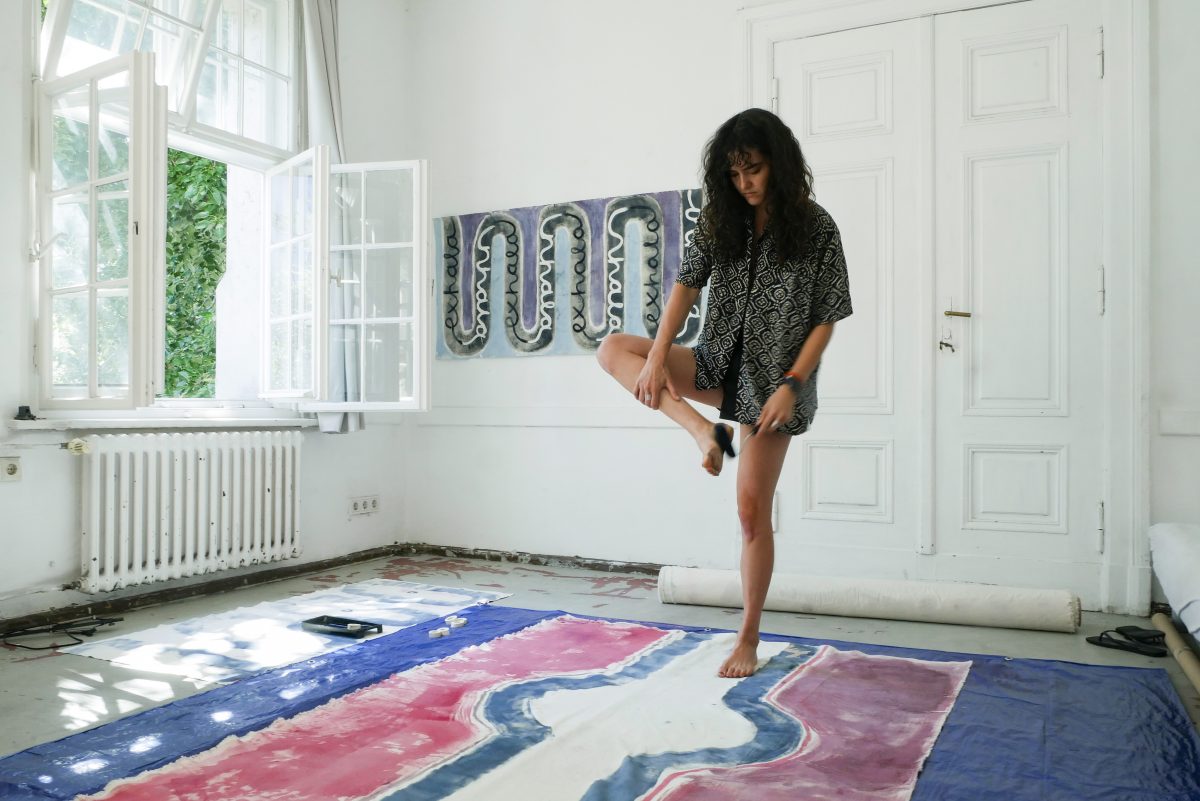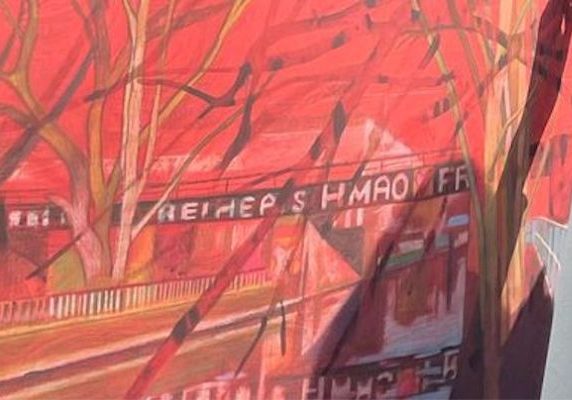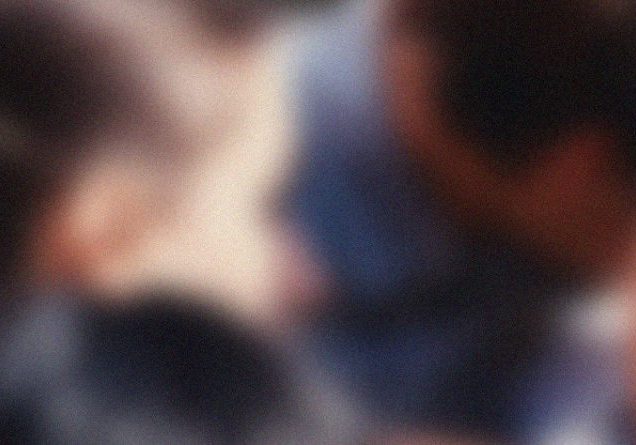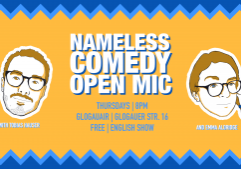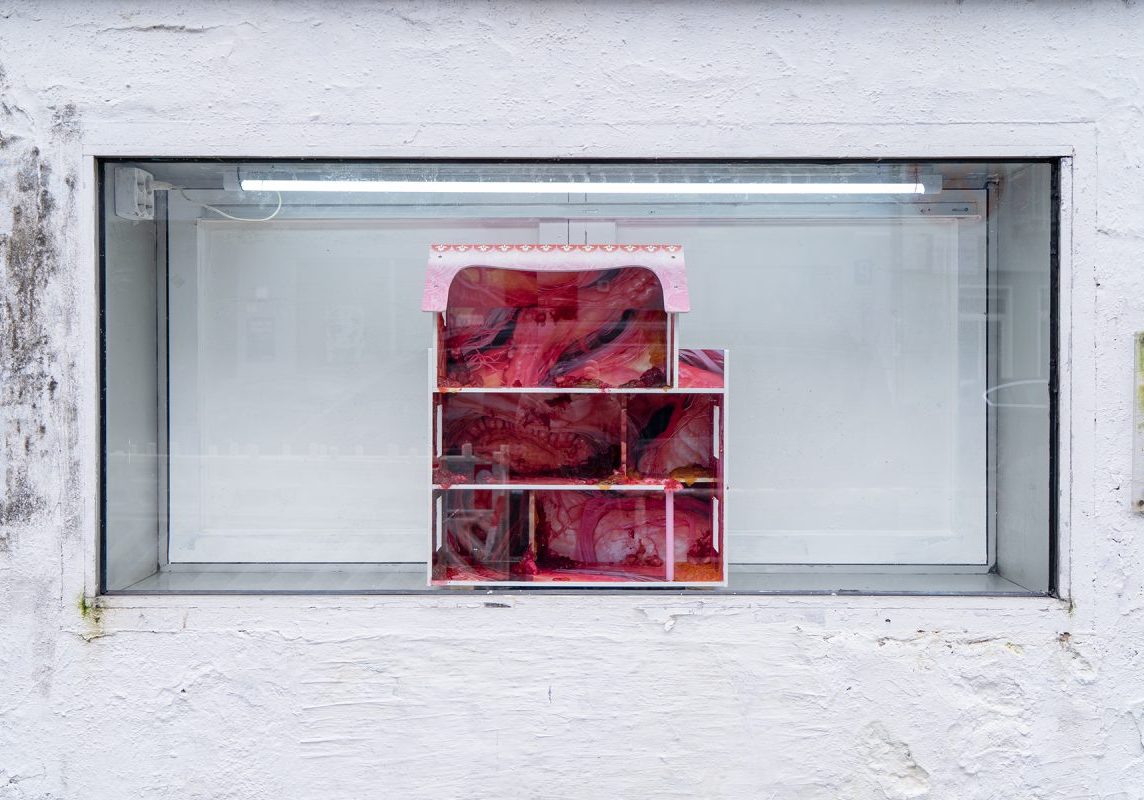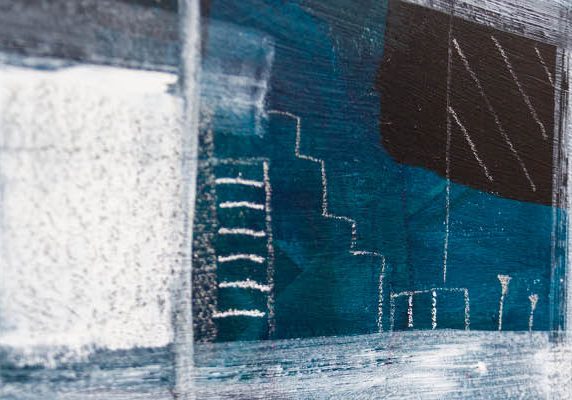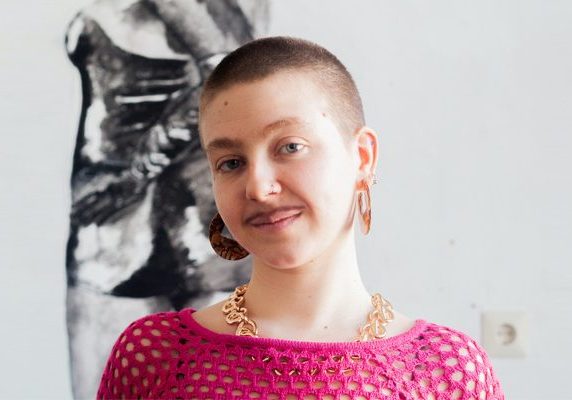Meet the Artist // Jamie Denburg Habie
Jamies work seeks to reveal unexpected relationships between multiple bodies (human, animal, earth and celestial) as a means to challenge dualistic perceptions of reality and propose tools for healing. She does that primarily by creating paintings that serve as scores for movement, sound and meditation, or that reveal shared materialities between beings.
Can you give us an introduction about yourself and about your practice?
I’m a Guatemalan artist and cultural practitioner and my work is definitely shaped by where I grew up and where I live. Not to say that certain themes don’t apply anywhere else, but the experience of growing up in Guatemala in the years after the Civil War ended, is significant to my practice in many ways. Guatemala is a country with a complex colonial history, and you see it everyday. Society is segmented, and this separation is what I believe continues to enable violence: The more you separate yourself from other people and from the earth, the easier it becomes to be violent towards them. This political context informs the “why” of my work.
Another belief that informs my work is that our perception of reality as linear and separable is illusory. I believe that everything is conscious and interwoven. If we study how we perceive reality, the neuromechanics of it, we would be more capable of being empathetic and connected to others and the earth. My work seeks to highlight these spaces of overlap, often serving as instructions to spark non-dual experiences, or feelings of interconnectivity where the lines of individual selfhood can blur.
Along these lines, I explore various fields—from somatic practices to meditation to neuroscience—as a means to study and reveal the underlying connections between things. Sometimes these are material connections. For example, you’ll see calcium in the studio, as well as bone ashes and volcanic sand. I’m interested in the shared evolutionary history of minerals and how much of the composition of different materials on the planet is similar—everything comes from the same place. I also search for techniques such as breathing exercises or physical movements that, both emotionally and cognitively, will help you feel more connected.

Tell us more about your inspirations for your work, the neuroscience and the material science behind it?
For sure, I think there are just so many different ways to arrive at similar conclusions, so I don’t limit myself to just one area of study. What neuroscience offers is an understanding of the frame through which we perceive everyday life. We often take for granted that reality is a certain way, but once you learn about how the brain works, you quickly realize that we evolved to survive, not to see the truth. In other words, there are many strategies your body has adopted that have nothing to do with seeing reality as it is, but rather with surviving the world. For example, there’s a blind spot between your eyes, but you don’t see a black hole in your vision. Your brain projects the space in between, giving you a seamless view of reality, but it’s fabricating that.
Another interesting aspect is the relationship between the body and other sciences, like physics. Time has long been proven not to be linear but rather subjective, depending on your position on the planet. The closer you are to the core of the earth, the slower time passes because of the effects of gravity. This applies to our lives – time passes differently if you live in the mountains compared to sea level. Additionally, the perception of time changes based on the neurotransmitters your body releases. For example, the more dopamine is released in your system, the more time you perceive has passed. For example, people in car accidents often say that the 10 seconds they were experiencing the emergency felt like an eternity.
Just how neuroscience reveals how our perception of reality is often skewed, spiritual and meditative practices can also convey similar ideas. One meditation method I often think about, for example, is called “The Headless Way”, a concept that has existed for thousands of years in different cultures across the planet but has been in the West popularised by Douglas Harding. If you look into the world, you won’t see your head. You can touch your head, but you’re not really touching your head—it’s pressure, texture, or sensation that you’re perceiving when you zoom into the feeling. When you look in a mirror, you see a reflection, not yourself. This meditation technique is simple, it asks you to find yourself, and very quickly you realise that you just can’t. We tend to feel that we exist behind our eyes and that reality starts there, but this technique shows that where your head is supposed to be is a world without boundaries. It’s a quick technique to illustrate that all physical sensations, emotions, and thoughts cannot be located, but rather unfold in a boundless, uninterrupted space.
There are different ways to reach this conclusion—neuroscience is one, meditation is another. Or at a rave while dancing, you might lose the feeling of being a separate person. These experiences point to how the line between ourselves and the world is much more malleable than we think.
Where do you find your materials?
For this project, I brought most of the materials with me, except for the calcium carbonate and the water-based glue, which is the kind used by kids. This glue helps bind the paint and is not toxic. I brought the indigo and cochineal from Guatemala, as well as the volcanic sand, bone ash, and the letter-shaped bones I use for stamps to write text.
The white paint you see here, down the middle of this painting, is made from volcanic sand I brought from Guatemala. When the painting is activated by walking down it, the texture is meant to evoke the feeling of walking on earth, with its rough, sandy texture. Although I could find similar materials locally, these specific ones are tied to a geological history that is important to me.
I have a funny story about travelling with bone ashes, which I get from the discarded cow bones from the butcher. I researched if you can put ashes on your carry on. Turns out that you can, human ashes. So, to be safe, I decided to split my supply between a carry-on and checked luggage. At security, the agent asked if the contents of my bag were sand. Based on her worried look, I nodded no, and with confidence said that I was carrying ashes, knowing it was allowed. She nodded in approval… Then, she asked for a death certificate. When I told her I didn’t have one, she advised me, with much seriousness, to leave security and check in my carry on [with my presumed relative’s remains]. I was about to miss my flight so instead I said “it’s ok, just throw them away,” noticing as I ran away how absolutely mortified she looked. She definitely must think I’m a monster, but there was no time for explanations.
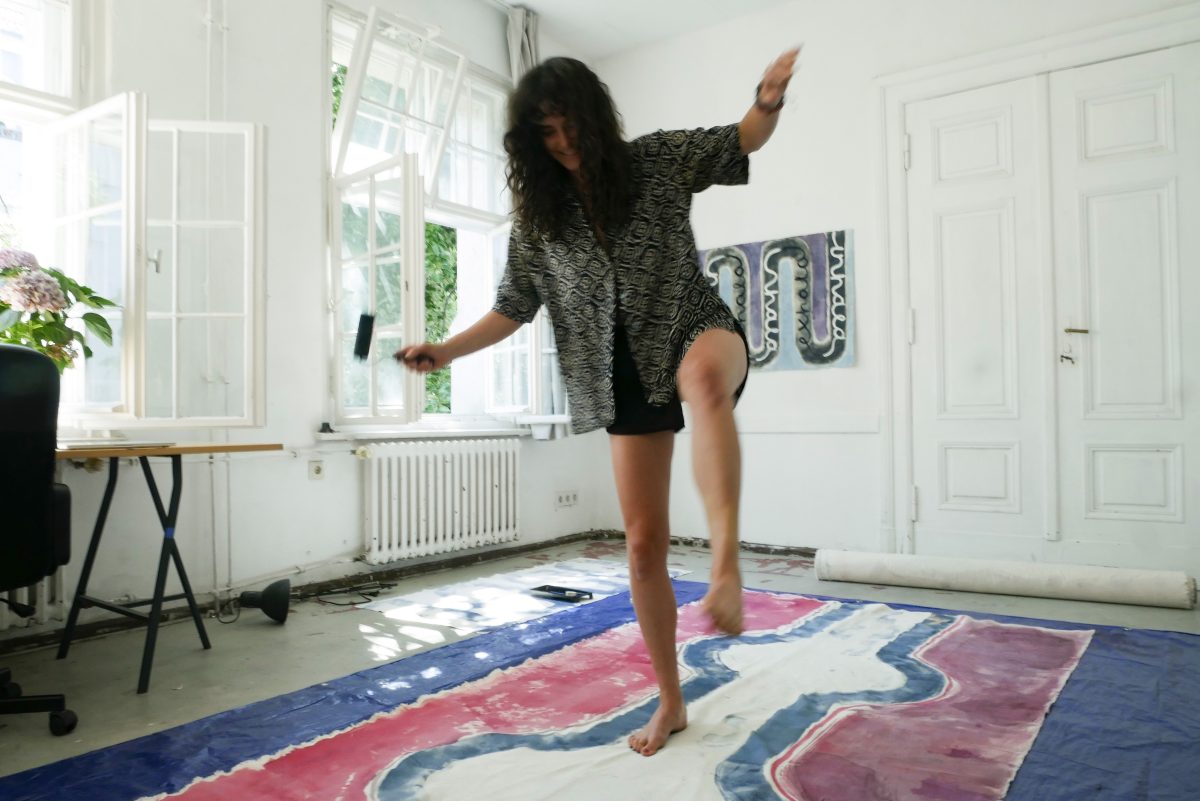
Who are some artists which have greatly influenced your artistic journey?
Thank you for asking this one – I really enjoy thinking about this. On one hand, I’m influenced by artists who work with topics of social justice, and on the other hand, by conceptual artists. For the minimal and conceptual artists, I would say that I’m a huge fan of the American painter Agnes Martin, who was a minimalist known for her very mathematical, repetitive gestures. She intuited that the body is algorithmic. It has been proven that your brain, for example, processes experience milliseconds before conscious awareness and projects a coherent reality based on past experience. In other words, your unconscious mind is already aware of everything and is piecing together a puzzle before you step into it. The only exception is when there is a miscalculation between your brain’s expectations and what actually happens. For example, if you’re walking, your brain is automatically anticipating what it’s going to feel like to step on the ground. But if you step on a nail, your whole body becomes aware of the gap between expectation and reality. Some scientists define consciousness as that moment.
Another conceptual artist I admire is On Kawara, who is known primarily for his series where he painted the date every day. He was also very algorithmic, giving himself a set of instructions: today I paint the date, and if I don’t finish, I destroy it. I love this simple meditative gesture. Every day he put the painting in a box with the front page of the, allowing for the work to be politicised, or to show the arbitrary construction of time, perhaps.
For more contemporary influences, there’s the interdisciplinary Mexican artist Tania Candiani. What I love about her artwork is that it shapes complex gestures into a coherent story and aesthetic, and yet, all her works have a strong political meaning and often involve participation. I appreciate how she combines urgent topics with a strong aesthetic appeal, in a way that does not diminish either.
I also admire the Guatemalan performance artist Regina José Galindo, whom I’ve had the pleasure of working with in my capacity as the cofounder of La Nueva Fábrica. She creates gestures with her body to protest various forms of injustice. For example, to represent the feeling of a country that always appears to be regressing politically, she hired a band to perform a several-kilometre backward march through the city playing marshall music. Sometimes quite repelling, but always minimal and clean, her gestures are always as sharp politically as they are strong aesthetically.
These are my references: on one hand, rather minimalist conceptual artists, and on the other, very political, performative, body-related work.
What is your relationship with the art world and the art market? What do you think about it?
In my 20s—I’m 33 now—I was really, really concerned, partially because I was living in New York at the time, which is a centre of the commercial art world. I was very concerned about external validation and had a lot of ideas like, “By this age, you have to have a gallery.” I had many notions of what it meant to be a successful artist. By the time I was 28 or 29, I started to drop a lot of that. I received some good advice along the way that helped change my perspective. I’m also lucky because by founding and working at La Nueva Fábrica (which started in 2010, the same year I started making art), I have other work where I find meaning, and which broadens my perspective with a goal that exists outside myself and beyond the scope of my life.
I think the art market moves faster than the mind can think. It goes so quickly that you don’t have time to create something of value; you just have to constantly produce. I was given really good advice by Christian Viveros-Fauné, the Chilean art critic and curator. When I was in my 20s, worrying about what to make and how to make it, he told me not to stress because he had never met a half-decent artist who was younger than 30. He meant that you have to live enough to have something to say. There are exceptions—people who live very quickly and do crazy things and then die young, of course. But often it takes life to share something meaningful about living.
During my brief time at CalArts, the advice that was going around was given by the artist Charles Gaines. He said your art career is a line that goes up and down, but your art practice exists on a different line altogether. Many people make the mistake of combining them and associating their art practice with their market value. By separating the two, you recognize that you may work for decades with no recognition (or maybe your entire life), so you start to treat your practice as its own world.
Regarding the art market, what else is there to say other than I think it’s crazy. It’s natural to want external validation, but it’s best to hold that desire lightly.
How are you finding Berlin, how is it influencing your practice?
I feel like I’ve been a little too ambitious with all the things I wanted to do here, like learning German. But I keep reminding myself, It’s not just about the amount of artwork I produce or the number of things I learn or exhibitions I go to, but also about the more emotional opportunity of letting myself experience a place freely without always thinking about the next thing. Being at Glogau has given me more opportunity to live and let myself experience the city.
Berlin itself has helped me in this sense too. I’m not just here to make art, I’m also trying to connect with the city as a home. If I can’t understand or engage with people in the native language, I feel disconnected from the culture. So learning German has influenced my experience here significantly.
Additionally, Berlin offers a lot for my research in terms of practical experiences around breathwork, meditation practices, yoga, and other activities in a wider range than what I have access to at home. I’m enjoying the music scene, for example, which often facilitates experiences that are totally embodied and disembodied at once. There are practical influences on my work from these experiences, but there are also aspects that are more about living than just making art per se. Being away from home gives my brain a moment where everything feels new, even though I know Berlin. This small window of newness allows for more possibilities because I haven’t yet decided what I believe about everything here. At home, you sometimes get stuck in routines and identities. In a new city, there’s a sense of, “What does Berlin Jamie do?” It’s different and feels good.
How are you finding GlogauAIR as a resident? How is it living with other artists?
While I’ve been spending a lot of nights offsite, I definitely enjoy the daily exchanges with fellow residents where we run into each other, talk about our work, share a meal, go on some of the program visits together, offer tips, etc. Community life adds a lot.
What plans do you have after the residency?
To go home to Guatemala, and to get back into my work at La Nueva Fábrica, where we also have a residency program. That’s another thing I enjoy about being at GlogauAIR — by experiencing a residency I learn about what could be useful for others. I exist as two streams intersecting and overlapping: on the one hand, I am a cultural practitioner who seeks to create opportunities for artists, and on the other, I’m an artist who is fortunate enough to receive an opportunity to experience life and work with newness.
